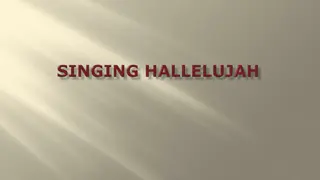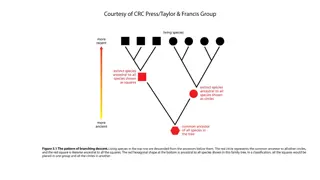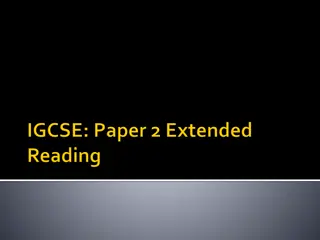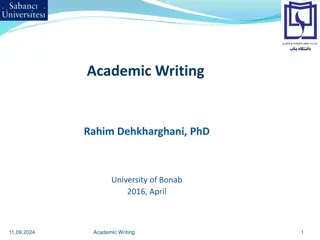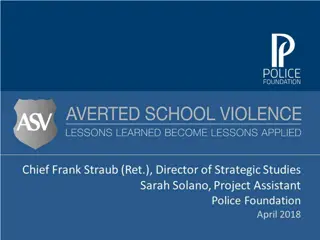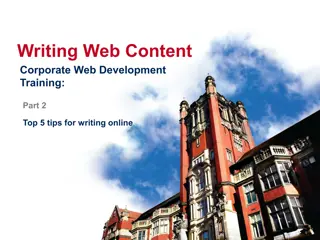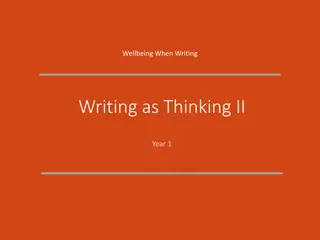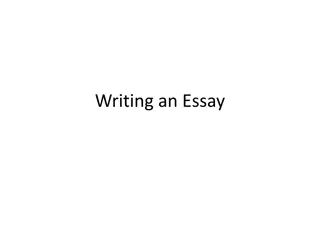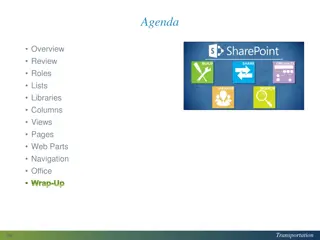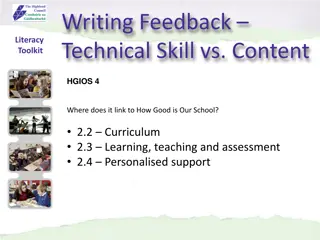Effective Tips for Writing Online Content
When writing for the web, it's crucial to be direct, concise, and engaging. Use clear headings and page titles, make your content scannable, adopt a conversational tone, and avoid passive voice. Frontload headings with important keywords and keep them short and descriptive. Choose descriptive page titles over vague ones and adhere to standard character limits for page titles. These strategies will help your content to be easily understood, engaging, and relevant to your audience.
Download Presentation

Please find below an Image/Link to download the presentation.
The content on the website is provided AS IS for your information and personal use only. It may not be sold, licensed, or shared on other websites without obtaining consent from the author.If you encounter any issues during the download, it is possible that the publisher has removed the file from their server.
You are allowed to download the files provided on this website for personal or commercial use, subject to the condition that they are used lawfully. All files are the property of their respective owners.
The content on the website is provided AS IS for your information and personal use only. It may not be sold, licensed, or shared on other websites without obtaining consent from the author.
E N D
Presentation Transcript
Writing Web Content Corporate Web Development Training: Part 2 Top 5 tips for writing online
Part 2 Top 5 tips for writing online 1. Be direct content that s understood quickly 2. Be concise edit or produce content so it s straight to the point 3. Make content scannable easy to scan read 4. Be conversational friendly and welcoming 5. Be active avoid using the passive voice, have helpful content
Top 5 Tips for Writing for the Web 1. Be Direct Use clear/descriptive page titles and headings sothey can be understood quickly. This is really important for search engines too, so your content appears in the right results. Always have a Brief introduction thatstates the point of the page, use keywords that your audience is looking for.
Headings & Page Titles Headings and page titles are very important. They are signposts to your content. They are crucial to helping people find your page: they will pull people into your site from a search if they are already on your site, they confirm to readers they are on the right page They can alsoappear in many different formats: they are the first thing your audience will see in search results they appear as links on home pages, or in sidebar navigation in social media posts
Headings & Page Titles Front load them so the most important words are at the beginning. This helps scan reading, making it easier and quicker for people to understand your content. Use keywords about your subject. Thishelps with better search engine ranking for your page, and also supports scan reading. Try to Keep them short so they re easier faster to read. Be clear and descriptive so it s easy to see the relevance of your page. This tells readers they are in the right place. Always avoid jargon or word play. Most people are on a task to find information. They will just ignore irrelevant/incomprehensible things to get to their destination.
Page Title Examples Descriptive title Gives a good idea of what you can expect if you choose to read the full article. Vague title This could literally be about any topic most people won t bother to read the summary or read more.
Page Titles Our Standards 50 characters (including spaces) Heading Level 1 (H1) for page titles using title case Menu items also use title case Only use ampersands in side menus. Use and in page titles and other text
Subheadings Always try to use Subheadings in your content. They break up content into easier to read chunks . People can scan read them quicker to predict what content will be on a page. They can then see if they are on the right page, and if they should invest time reading more. They can tell a story. Subheadings visually stand out more so are easier to scan read. This helps people pick out relevant information. Use keywords to support scan reading Keywords supports scan reading the 'F' shape reading pattern
Subheadings Our Standards 30 characters (including spaces) H2 to H5 for sub-headings using sentence case
Headings & Subheadings Example Good Short but descriptive Page title Uses subheadings to split up text and to introduce each section Supports scan reading
Headings & Subheadings Example Bad Page title too long - hard to read Subheadings are used, but followed by bullet points no context given for each section Subheadings too long hard to read Use of question format is harder to comprehend (especially for international students) and clashes with tone on the rest of the page.
Introductions Every standard page should have a short introduction. A good introduction can orientate readers. It tells them they are in the right place and they ll get the information they want. You have about 3 seconds to get a readers attention and 5 to keep it. If it s not clear what a page is for, people leave. Our introductions are Styled differently from the main body content.
Introductions Our Standards Fewer than 50 words Summarise the main point of the page Use keywords to support search engine optimisation
Top 5 Tips for Writing for the Web 2. Be Concise Keep your content brief and your users are more likely to read it Focus on what your visitors want to know, or do
Page Content Think about how to answer your audiences questions and make sure they can complete tasks (apply, book, download, contact) Writeusing sub headings, short sentences and short paragraphs Remove unnecessary words - Please note , Fill in this form by , Thank you for visiting Our Standards 200-300word count (including an introduction) 20 word sentences 50 word paragraphs (around two sentences)
Page Content Always check your content Accuracy make sure links work and there are no misspellings. As a university this is particularly important. Currency is it up to date? If your information is out of date how reliable can it be? Remove references to past events and old documents. Out of date content automatically makes people think you don t take care. Readability read it through. Is your message clear? Could it be more direct or simple? Follows our standards check your content against our standards http://www.ncl.ac.uk/demo/editorial-guide/
Page Content Check your readability - fast Use the free, online Hemingway Editor to check/improve your readability. The lower the score the better! http://www.hemingwayapp.com/
Hemingway Editor Demo Paste/write in your content Hemingway makes suggestions to improve your readability, and colour codes them Make your edits online to see your score improve (The lower the better) Copy content back into word
Example Before Editing This example is taken from the UG website Grade 13 is OK But can be improved with a couple of small changes
Example After Editing Long sentences have been split up - shorter and easier to read Removed some adverbs not really needed Improved readability score - Grade 10 Good Simple but effective changes
Top 5 Tips for Writing for the Web 3. Make Content Scannable Visitors to your site won t read from start to finish They will scan around the page looking for visual pointers
Scannable Content Reading online is different to print. People won t read all of your content - theyscan. They noticethe first paragraph, words and headings known as the F -shaped pattern. They also look for visual pointers: sub-headings lists bold keywords Task-focused if you don t answer people s questions, they go elswhere. You have about 3 seconds to get a readers attention and 5 to keep it. If it s not clear what a page is for, people leave.
Scannable Example 1 Good Short and descriptive page title Concise introduction List iseffective in highlighting what s on offer, breaks up text and adds white space Hyperlinks are relevant and helpful Bold phrases highlight key information Short sub-heading is descriptive and introduces content that follows
Scannable Example 2 Bad Longer blocks of text hard to scan read No subheadings to break up text, or introduce content blocks No bold to emphasise key phrases No lists to add white space or emphasis key points
Lists Lists are used to break up your content. They are: easier to read use fewer words and introduce white space fragments or phrases,not full sentences Use: a minimum of three bullets and up to six bullets points rather than numbers only use numbered lists to guide a user through steps or a 'top 5' bold to emphasise, start with key words
Standards for Lists Bulleted lists: follow on from a colon start each point in lower case and don t end with punctuation begin with keywords keep each point short aim for around 10 words Numbered lists 1. Don t follow on from a colon. 2. Start each step with a capital and end with a full stop.
Lists Example 1 Bad Our volunteers are currently involved in a range of activities, including: Grey shading shows scan reading focus Uses capital letters at start of each point Being the welcoming face of our venues. Volunteering in the stores and helping to catalogue our extensive collections. Volunteering with the learning teams to explain exhibits to visitors. Bringing our rail heritage alive by helping with the day to day running of the museum. Stewarding or assisting with the organisation of special events. Full sentences, with punctuation harder/slower to read Repetition of words at the beginning of each point
Lists Example 2 Good Our volunteers are involved in a range of activities: Grey shading shows scan reading focus welcoming visitors and providing information cataloguing our extensive collections explaining exhibits to visitors and facilitating exhibitions day to day running of the museum to bring our rail heritage to life stewarding or assisting with the organisation of special events Bold on some words for emphasis, help scanning Points start with keywords and uses different, action words for each point
Bold Use of bold helps with scannability and emphasis: bold text creates a quickly scannable at a glance impression of the page, telling users what to expect from the content works for humans and computers - highlighting key phrases in bold helps to improve search engine optimisation (SEO)
Bold You should bold text that: communicates important information emphasises key points makes sense out of context complements titles and headings An easy way to check if you ve used bold effectively is to collect your bold phrases into one list. If you gave this list to someone, would they understand what the page is about? Always add bold after you ve finished creating your content.
Bold Bold is the only formatting you should use to add emphasis. Don t: make entire sentences or paragraphs bold make too many individual words bold use italics for emphasis hard to read online use underline text for emphasis ONLY used for hyperlinks use CAPITAL LETTERS for emphasis too shouty!
Top 5 Tips for Writing for the Web 4. Be Conversational Use a friendly and welcoming tone of voice Imagine you re talking to the reader and write as you d speak
Tone of Voice Write in a conversational tone, be friendly and welcoming: address the audience as 'you You can find out more about use contractions eg we ll, you re use simple short words and clear language: 'before not 'in advance of 'send' not 'transmit Always remove jargon to reduce formality, and increase understanding cut caveats like please note See the Plain English Guide (PDF: 174KB) for other ways to simplify your language
Top 5 Tips for Writing for the Web 5. Be Active
Active Voice Using an active voice rather than passive voice: helps with your conversational style encourages your users to engage with your content helps your users complete their tasks you write great web content not great web content is written by the team
Active Voice Examples Use active voice in your content, then it s naturally direct: Active voice: Someone has cleaned the windows Passive voice: The windows have been cleaned Active voice: The girl was washing the dog Passive voice: The dog was being washed by the girl Active voice: Beautiful giraffes roam the savannah Passive voice: The savannah is roamed by beautiful giraffes.
Helpful content Your aim is to help a user find an answer or complete a task, not to keep them on your website: if you want them to complete a task,help them with your words and hyperlinks link to relevant content elsewhere - don't duplicate content on your site if it's somewhere more appropriate do you need to introduce something to them: a video, related content, contact details?
Hyperlinks Hyperlinks help you to write actively, support scan-reading and enhance search engine optimisation. They: help highlight keywords because they underline give active instructions should prompt you to do something offer a next step: place links at the end of your content are always descriptive do not use click here or download must work check that they go to the destination page But don t group too many together it s harder for mobile readers to hit the link targets on smaller screens.
Hyperlink Standards Writing Web Content Corporate Web Development Training: Hyperlinks are descriptive and meaningful link phrases of 3-4 words not entire sentences or paragraphs always open destination content in same window users can choose to open a new tab Be active Part 2 Complete 1. Be direct 2. Be concise 3. Make content scannable 4. Be conversational 5.








